The Anchor brewery in the City of San Francisco deserves a guaranteed place on any list of the most important brewing sites in the world. Not only is Anchor the last surviving pre-Prohibition brewer of the historic local style of steam beer, it’s also arguably the starting point of the modern craft beer movement and played a key role in the resurrection of porter and the diversification of beer styles in the United States. The warm welcome it lays on to visitors additionally makes it an essential stop on any beer tourist’s itinerary.
So it was remiss of me to visit San Francisco five times before I finally found my way to the brewery in October 2012. While there, as well as taking the brewery tour, I had the chance to interview veteran head brewer Mark Carpenter, who has worked there since the early days of the brewery’s renaissance in 1971. In the time it’s taken me to write this up, things have moved on further, with Mark entering semi-retirement while Anchor prepares for a major expansion to a second site in San Francisco.
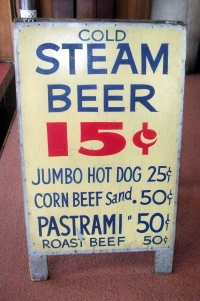
Steam beer in old prices, Anchor brewery, San Francisco.
The Anchor story should be a familiar one to anyone who has ever read a couple of world beer guides, and you’ll hear it retold in energetic style on the brewery tour. Steam beer evolved as expatriate brewers from the German-speaking world arrived in rapidly expanding Gold Rush-era San Francisco with lager yeasts developed to ferment at low temperatures, only to find a complete lack of cold caves, cooling equipment or ice.
Luckily, the City’s unusual geography ensures a climate that’s considerably cooler than surrounding areas, so the brewers found they could just about make things work by using broad, shallow fermenting vessels, similar to the koelschepen employed in lambic brewing. The greater surface area permitted more rapid cooling, sometimes boosted by locating the vessels on rooftops where they benefitted from ocean breezes. The resulting beer, though drinkable, was a sort of halfway house between a lager and an ale, with a particularly high carbonation and distinctive flavours produced by yeasts working outside their comfort zone.
The origin of the term ‘steam beer’ is uncertain – Anchor claims it referred to the steam given off when hot wort was pumped into rooftop fermenters and exposed to the chill of a foggy City day, creating a haze that hung over the breweries. The hiss of carbon dioxide as barrels of this very fizzy beer were vented could also have reminded people of steam. And some of the brewers might have been familiar with Dampfbier, a straight translation of steam beer – this was a Bavarian warm fermented style named, so it’s claimed, because the vigorous activity of ale yeasts on the surface of the wort resembled boiling and steaming liquids.
By the end of the 19th century, steam beer was the standard everyday beer style of San Francisco, a cheap blue collar refresher made by around 25 breweries. One of them was Golden City Brewing, founded in 1871 in a former saloon on Pacific Street near Russian Hill by German immigrant Gottlieb Brekle. In 1896 the brewery was sold to two other businessmen of German descent, Ernst F Baruth and his son in law, Otto Schinkel Jr, who renamed it Anchor – a common brewery name in Europe and one particularly appropriate to such an important port city.
The partnership proved ill fated. Baruth died suddenly in 1906, just two months before a massive earthquake devastated San Francisco. The brewery withstood the initial quake but was consumed by the fire that followed it – a dog grooming service stands on the site today.
Schinkel rebuilt Anchor at 18th and Hampshire streets, the first of four sites in the general area of Potrero Hill where today’s brewery stands – these southeastern suburbs were favoured by relocating businesses as the underlying geology was more rocky and solid than the sandier neighbourhoods north of Market Street, and had suffered comparatively little earthquake damage. Only a year later Schinkel died too in a freak accident, run over by one of those characteristic City icons, a cable car. Two other Germans, Josef Krauss and August Meyer, then took over.
Prohibition wreaked far greater devastation on the brewing industry than any earthquake or fire. There’s no record of Anchor’s activities during the dry years of 1920-33, though there are some suspicions that it continued operating illegally. In any case it became one of only 164 US breweries out of 1,392 to re-emerge once the madness was over, and the only remaining steam beer brewery in San Francisco.
But now it faced a new challenge – the rise of the giant brewing combines with their heavily marketed national brands, whose dominance increased ever more quickly after World War II. The original rationale for steam beer was long gone, with technology now widely available to produce bland, though clean tasting, golden lagers that suited the streamlined and slickly branded ethos of the Big is Beautiful 1950s.
Under Krauss and a new partner, Joe Allen, Anchor soldiered on at a new site at 17th and Kansas streets, having relocated again following another fire only a few months after repeal. But demand steadily dwindled, not encouraged by hygiene problems that frequently resulted in infected beer, and in 1959 Allen, who had outlived Krauss, shut up shop. The next year a new owner, Lawrence Steese, reopened Anchor on Bryant Street but was soon struggling to make it pay.
Enter Fritz Maytag, a still youthful Stanford graduate and heir to a washing machine empire on the lookout for a mission in life. Maytag had already attempted to get into the drinks business by becoming one of the first to import Chilean wine to the US, with little success. One day in 1965, so the story goes, he was enjoying a steam beer at North Beach beatnik haunt the Old Spaghetti Factory when owner Fred Kuh advised him to make the best of it as the brewery was about to close.
Intrigued, Maytag visited Anchor and, despite finding a decrepit and rat-infested plant which he later described as “mediaeval”, ended up buying 51% of the company to keep the steam beer flowing. He spent the next few years learning all he could about brewing, with numerous brewery visits and study tours, including to Europe, and finally took on full ownership in 1969.
It’s tempting to view Maytag’s intervention as a romantic folly, the sort of risk no rational, sensible capitalist should ever take, but which nonetheless eventually paid off many times over, not only in financial terms but in the impact of what followed on the world of brewing. A real San Francisco tale, indeed, of a successful challenge to conventional wisdom. But while I’m sure there was an element of impulse and inspiration, the investment was shrewder than it might at first have seemed.
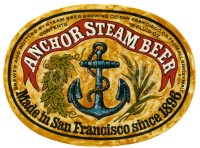
Anchor Steam Beer.
By the mid-1960s, the glamour of consumer society that had so seduced the previous generation was wearing thin, and a critical discourse emerged to challenge the homogeneity of large scale production and the intellectual vacuity of mass marketing. Significant groups of consumers, particularly among the newly educated and economically empowered baby boomer generation, began demanding products that appeared more authentic, natural, idiosyncratic and hand crafted than prepackaged supermarket fodder. If these came with a whiff of nostalgia for an earlier pre-corporate age, so much the better.
San Francisco was a city with a long tradition of radicalism, progressiveness, rugged eccentricity and alternative lifestyles, a tradition shortly to achieve perhaps its most famous expression as the local hippie culture went global with the 1967 Summer of Love. San Franciscans were way ahead of the trend in seeking alternatives to the offerings of corporate America. If they could be persuaded to take a beer into their hearts, then steam beer – as quirky and Victorian as the painted wooden houses so beloved of Haight-Ashbury longhairs – was the perfect candidate. And the association of the beer with the City would help too in catching the eye of discerning drinkers elsewhere, whom Maytag knew he had to reach if the project was to be viable.
“Fritz had unbelievable foresight,” says Mark Carpenter. “He saw what was coming when I swear no one else did. His very first big contribution, aside from all the great beer and the creativity, was that you could get a higher price for a domestic beer. No one was doing that. All the small regional breweries were all selling under the price of Budweiser, Miller and Coors. That’s no recipe for success. Fritz had the nerve and pride to charge a higher price, between national brands and imports. He had the wherewithal to be very patient and let it grow and become profitable, and by 1974 we were profitable and have been in profit ever since.”
Though Mark wasn’t in at the very beginning of the new era, his history with Anchor dates back to the days when Maytag’s patience was most tested. Mark joined in 1971, just after the owner had made another crucial decision, investing in a small bottling machine. Now steam beer was available in bottles for the first time, giving the product a reach far beyond its traditional market of local saloons and bars and accessing a more affluent and widely dispersed customer base.
“I guess I was looking for a change in my life,” recalls Mark. “The 1960s were just over and people were doing different things with their lives, an amazing time really in San Francisco. I worked for a telephone company – I was doing just fine, I’d worked my way up there since high school, but I just wanted something more interesting. I took a tour of the brewery with a couple of friends and thought I should ask for a job here. So I went back a few months later and luckily I got in to talk with Fritz and we got along and he hired me.
“It was such a cool time, and the perfect learning environment. We had this old 57 barrel (67hl) brewhouse but were only making a little under 1,000 barrels (1,173hl) of beer a year, so we didn’t have to brew much, only once every few weeks. There were only five of us – Fritz, the secretary and three of us in the brewery. When we bottled, Fritz and the secretary would come out and help us.
“Fritz was developing an entirely new market when we started bottling in 1971. We couldn’t even get into Fisherman’s Wharf [a picturesque tourist honeypot centred on a quayside historically used by small fishing boats], even though we had a beer in a bottle with an anchor on it, made here in San Francisco. So we had to go further afield. We used Guinness as an example, because back in the early 1970s Guinness was in many bars in the United States, and although you rarely saw anyone drinking it, they sold about 75,000 barrels (88,000hl) in total. That’s the sort of market Fritz was aspiring to, a specialist beer.”
Another crucial instance of Maytag’s farsightedness was his recognition that resistance to the homogeneity of industrial brewing would eventually express itself in the demand for variety of beer styles, each with distinct flavours. In 1973, Anchor launched its first new beer of the modern era – a porter. Today such a move wouldn’t merit even a twitch of an eyebrow, but back then it was brave and radical and, perhaps, as romantically irrational as taking on the brewery in the first place.
Porter, the beer that originally drove the industrialisation of brewing and the first world beer style, had fallen extinct in its British homeland in the 1950s and had disappeared from the US years before that, though it survived as a minor cold fermented speciality in Northern Europe. Anchor Porter, brewed with ale yeast, was almost certainly the first warm fermented porter of the contemporary era.
There was some historical precedent for a San Francisco porter. When Maytag bought Anchor, the brewery did have a second, dark beer – a distant echo, perhaps, of the German custom of offering a light and a dark lager. But the dark beer was simply the regular steam beer with caramel colouring. “That was not Fritz’s style,” says Mark. “But we also had some old advertising for porters brewed here from before prohibition, so there was a bit of a story there.”
Mark recalls challenging his boss’s judgement. “I asked him, ‘Why are we making this porter? This is just extra trouble for us when the steam beer’s going real well.’ And he said to me, ‘Look, Mark, pretty soon there’s going to be lots of little breweries around the US making a number of different beers and we can’t be seen just to be making Anchor Steam Beer’. It was incredible when I look back on that conversation and the foresight Fritz had.”
The innovations kept coming. In 1974, Maytag returned from a visit to the UK with a fascination for barley wine, another style then unknown in US brewing. He’d been struck, says Mark, by “how it had fallen completely out of favour, the only time you’d see people drinking it was a couple of little old ladies in the corner of a pub, but that was just down Fritz’s alley. He told us how they all have funny names like Owd Roger or Old Nick, so one of the guys said how about Old Foghorn and the name stuck.” Anyone who has ever spent time in the City and heard the mournful chorus of foghorns that strikes up to greet the frequent incursions of ocean fog will recognise the local relevance of the name.
By 1975, the bicentenary of the signing of the Declaration of Independence was only a year away and the nation was gearing up to celebrate. “But it wasn’t Fritz’s style to jump on that one,” Mark recalls, “so he goes with the 200th anniversary of Paul Revere’s ride in 1775, on April 18th, which also happens to be the anniversary of the earthquake.”
The response was arguably Anchor’s most influential beer, Liberty Ale, the first beer to use Cascade as an aroma hop and the first dry hopped beer in the US. The irony of borrowing the latter characteristically British technique for a beer commemorating a key event in the successful rebellion against British rule was doubtless intentional. At the time some people said the result was too highly hopped to be drinkable. “Liberty Ale hasn’t changed,” comments Mark. “But drinkers’ tastes have.”
Later additions to the range included the first US seasonal craft beer, Christmas Ale (sometimes known as Our Special Ale), also in 1975; Summer Ale, the first American wheat beer since Prohibition, in 1984; and Small Beer, a revival of the old European tradition of producing low alcohol everyday beer from the second runnings of the mash, in this case from Old Foghorn, in 1998. “It’s the only draught beer we can sell in Utah,” comments our tour guide Daniel.
By then the brewery had relocated to its present site, a handsome old coffee roasting plant with art deco flourishes, just over the crest of Potrero Hill. “We bought it in 1977,” says Mark, “and it took us two years to convert it. We had to sandblast the entire building as it still smelt of coffee – a wonderful smell, but not for a brewery! At that time we never thought we’d fill it, so we rented out part of the warehouse.” But the 1980s turned out to be a prosperous period for the brewery, and it soon needed “every inch” of space.
In 1993 Maytag set off in yet another direction by adding a craft distillery at a time when these were relatively rare. The first product was a single malt rye whiskey, Old Potrero, joined in 1997 by Junipero gin – its name referencing Father Junipero Serra, the evangelical Mallorcan-born Franciscan monk in charge of founding the first permanent European settlement in the area, the Misión de San Francisco de Asís, not far from the present brewery site, in 1776. Serra rather fortuitously shared his first name with that of juniper, the perfumed berry used in flavouring the spirit and the origin of the word ‘gin’ itself.
After tapering off a little in the 1990s, the last decade has seen Anchor once more in rapid growth as the craft beer sector as a whole has started to go mainstream. Where once few in San Francisco would touch its products, now, as Mark says, “it’s hard to find a bar in the City without them, thank God.” Exports, particularly to Scandinavia and the UK, also make a major contribution to sales.
Mark’s recollection of how the export side first developed reveals the steelier side of Anchor’s inspirational saviour. “Our first exports were to the UK because there were people ripping off the steam beer name and Fritz was keen to protect it,” explains Mark. “You can’t stop them if you’re not selling too, so Fritz figured even if we lost a little money on exports it’s a lot cheaper than hiring lawyers”.
Indeed Maytag has been assiduous in his efforts to reserve ‘Steam Beer’, which before Prohibition was simply a generic style designation, as an exclusive Anchor trademark, a policy that, while successful, has not been uncontroversial since registration in 1981. One result has been the coining of the rather inelegant term ‘California common’, now used in official style guidelines such as those of the Brewers Association and the Beer Judge Certification Program (BJCP) for beers using comparable techniques of forcing lager yeasts to ferment at warmer temperatures.
All enterprises largely driven by a single individual eventually encounter the question of succession and in the late 2000s, as Maytag reached his 70s, he began looking for a buyer for the brewery. “Fritz knows he’s not the type of person to let somebody else run his business, so he decided to sell it outright,” comments Mark. He found what he was looking for in the Griffin Group’s Keith Greggor and Tony Foglio, two local entrepreneurs with a similar long range vision who had previously played a role in the success of specialist vodka brand SKYY. They took control in August 2010.
The new owners promoted Mark to Brewmaster, encouraging him to experiment with some of the ideas he’d not been able to convince his old boss to authorise. “We don’t have a pilot brewery, so you think twice about how much you’re going to experiment,” Mark explains. “After a while we kind of stopped making new styles. There was this period in the late 1980s with brewers making all these goofy styles like apricot ale that were unappealing to us, so we backed off. But the new owners were keen to add new beers.”
The first fruit of this new approach was Brekle’s Brown, an unusual but highly successful brown ale that both tips its hat to the original founder of the brewery and foregrounds the very contemporary flavour of the Citra hop. In 2011 Mark celebrated his 40th year at Anchor with the launch of the Zymaster series of annual specials, the first of which fulfilled a long held desire to brew a mild. Late in 2012 the brewery launched Californian Lager.
All these beers perpetuate a tendency to look to Europe’s brewing heritage for inspiration, and a fondness for easy drinking quenchers that until recently contrasted with the popular image of US craft beer.
“I’m not a big fan of high alcohol beers because my elbow goes at a certain rate and you just get too drunk,” says Mark. “That’s what I like about visiting England. With something like my Mark’s Mild you can drink it all evening and still be in good shape. I thought, I’m never going to win the hop war, no one is going to think, ‘Man, has Anchor outdone everyone with that one,’ so we just tried to do other things. But now of course the craft beer pendulum is swinging back towards session beers.”
The brewery’s sense of place remains important. “That’s probably what helped us survive early on,” Mark reflects. “There are many disadvantages to brewing in San Francisco, we are brewing in one of the most expensive environments you could have, but we have all these wonderful tourists that come see us. They’re not going to Chico to visit Sierra Nevada, not that their brewery isn’t interesting but it’s out of the way. And which other brewery has a view like ours?” He’s referring to the impressive vista of the City and San Francisco Bay from the windows of the highly amenable tasting room with its fascinating collection of breweriana where our tour starts.
The neat little brewhouse is immediately visible through the glass partitions of the tasting room. A German-built 150hl (125 US barrel) copper kit dating from the 1950s, it was acquired during the move to the current building in 1977 from a small brewery in Karlsruhe which was going out of business. “We even bought the fourth vessel which German brewhouses always have, the decoction vessel,” says Mark, “but we don’t need it as we do an infusion mash, and sadly I’ve never been able to find an alternative use for it.” A whirlpool system clears the wort before fermentation.
With up to six brews a day emerging from the kit, it’s certainly put to good use – Mark says they could go up to seven batches a day but lack the fermentation capacity. The total output currently stands at 110,000 barrels (130,000hl) a year, of which about 60% is bottled, and with around 150 staff the brewery is a remarkably compact operation for such a well known brand.
“Compared to some of our competitors, we’re still a very small brewery – Sierra Nevada is ten times our size,” observes Mark. “Sierra’s founder Ken Grossman had a whole different set of goals to Fritz, who always wanted a simple operation that was fun and profitable, a five day a week operation with the vast majority of people on a single shift and where he knew everybody personally.”
One change under the new regime is greater openness about recipes and ingredients, which were formerly the subject of much secrecy. “We still don’t like going into detailed specifications,” says Mark, “but I’m happy to tell you we use US two-row pale malt. The pale is all Western malt which is famous for being the best in the US if not the world. Fortunately we live here so it’s easy to get it. Before Fritz owned it, the brewery was going through hard times and used sugar in Steam Beer. But since Fritz took over all the beers have been all malt. Steam is mainly pale with some caramel, and Northern Brewer hops. That hop was going away, dramatically, and we helped revive it.”
Mark insists that there has been no change to this basic steam beer recipe in the four decades and more that he’s been on the payroll. “Within my first month at the brewery, [well known Portland, Oregon-based brewing historian and home brewer] Fred Eckhardt came down to brew with us. Then about eight or nine years ago I was doing an event with him and he said, ‘You guys have changed your steam beer,’ and I said, ‘No, we haven’t.’ So he started to ask me what’s our original gravity, what’s this and what’s that, and then he pulled out his notebook with his notes from the 1970s and said, ‘Well, you’re right’.”
Behind the brewhouse is the unique feature that provokes such interest among brewing geeks – the steam room. The traditional shallow fermenters are still present and correct, though don’t expect to see them steaming on the rooftops; instead their contents bubble away behind glass in a temperature controlled chamber with filtered air.
“In the old brewery they still had a fermenter made from redwood lined with pitch,” recalls Mark, “but they’d since lined it again with stainless steel. It had pretty crude welds around the joints and we had to get a torch out and heat them up every couple of months to keep the bacteria down. Then we were still fermenting in the old fashioned way, taking advantage of our cool climate here. We didn’t have filtered air, but if you give me good clean water and a clean fermenter and clean yeast, I can give you clean beer in an open room.
“The current fermenters, although they keep that same shape, we made when we moved into this building. We maintain that room at 61°F (16°C), and I think we spend more time heating it than cooling it!
“When I started,” Mark continues, “we brewed so rarely and didn’t have the ability to cultivate yeast so we would borrow yeast from other breweries every time. Then in 1974 or 1975 we got a very old strain of Wallerstein Labs lager yeast and that’s what we’ve been using ever since. Wallerstein Labs no longer exists but their yeast lives on here. We just collect it from the fermenters and reuse it. So many brewers today say they have to change the yeast after so many generations but we’ve never found that necessary.
“We also have an ale yeast we got years ago and that’s what we use for all our ales, even the wheat beer. We recently did a special high alcohol export stout for the Great British Beer Festival and for the first time in many years we brought in a different yeast.”
Downstairs in the Ale Room is a sight that will be familiar to habitual visitors to British breweries but is nonetheless relatively rare in the US – a set of stainless steel ‘Yorkshire Square’ style fermenters, not as broad and shallow as the steam room vessels but also open. These are used not only to ferment all the rest of the regular range, but also to finish off fermentation of the steam beer – after three days in the shallow vessels, it’s pumped down here for three more days.
In the basement is a densely packed lagering hall with cylindrical tanks where the beer receives its final conditioning – Steam Beer spends three weeks down here at a temperature of around 0°C. At the back of plant are two busy bottling lines: the biggest, for the standard 12oz (355ml) bottles, fills 420 bottles every minute, while the second is for 22oz (650ml) bottles and magnums.
One significant departure from old fashioned methods that might disappoint purists is that all the regular brands are flash pasteurised, both in bottle and keg, a practice introduced by Maytag early on as part of his crusade against infection and unreliability. Given the increase in hygiene since then, the practice is perhaps less justified than it once was, but certainly the beers don’t taste the worst for it – Anchor products today are excellent and flavoursome beers and include at least a few world beating classics.
I wonder whether Mark has any views on how the big changes in craft beer in recent years might impact the brewery in future. “We always looked to Europe to inspiration,” he reflects, “because there was no inspiration domestically, but now you have the whole world creating unusual beers and I think you’ll see us doing a lot more different beers.
“The styles I’m most interested in are the styles I haven’t brewed yet. There are many styles out there that brewers never seem to look up. I don’t want to talk about it because I don’t want to give away any ideas, but it surprises me that everyone seems to be stuck with very highly hopped IPAs and Imperial Stouts when there are so many other possibilities.
“What I do see changing is – we and a handful of other older craft breweries distribute our beers nationally, which we had to do in order to make money. If Anchor started up now, we would probably only sell in California because we could make a living doing that, the market is there. So will brewers like us who sell over wide areas still be able to sell over wide areas? I don’t think we’ll lose our market in the major cities, but in these little areas where you have all these little local breweries, are we going to have to pull back from those areas? It’s going to be interesting to see how it shapes up.”
Since my visit, Anchor’s confidence in the future has been signalled by the announcement in February 2013 of a major new project to quintuple its capacity from 120,000 to 600,000 barrels (141,000hl to 704,000hl) a year. Several other Californian craft breweries, including Green Flash, Lagunitas and Sierra Nevada, are also working on expansion plans, but these all involve new plants on the East Coast. Anchor, meanwhile, is staying true to character by expanding within San Francisco.
The site is Pier 48 at Mission Rock, a major new mixed use development on the eastern waterfront facing the Bay, on land belonging to the City’s successful baseball team the San Francisco Giants and adjoining their stadium at AT&T Park. The plans include a restaurant and visitor centre/museum as well as a new brewery. Construction is due to start in 2015 and the new facility could be online by 2018.
Anchor’s progression – from rough and ready supplier of an everyday quencher that barely merited a passing thought among its customers to world famous tourist attraction and cultural icon – is a striking demonstration of the transformation of brewing in the craft beer era. Fritz Maytag’s insight in the late 1960s that a whole new and more middle class audience might be prepared to pay a bit more for traditional local beer styles established economic credibility for the huge growth in craft beer that followed. And Anchor’s nostalgic reclamation of its working class roots was a forerunner of the post-industrial style now exploited not only by craft brewers but by other specialist food and drink producers across the world.
But above all Anchor made, and continues to make, good beer – and without that, none of what followed would have been possible.
Read notes from the Anchor tasting room.
Visit Anchor’s official website.
Thanks to Mark Carpenter, tour guide Daniel and Candice Uyloan of Dog and a Duck PR for setting up the interview. The history of Anchor outlined above is drawn from the brewery’s official history on its website, information imparted during the tour and the brewery’s entry by Jay R Brooks in The Oxford Companion to Beer.



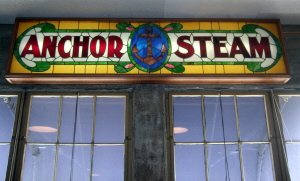
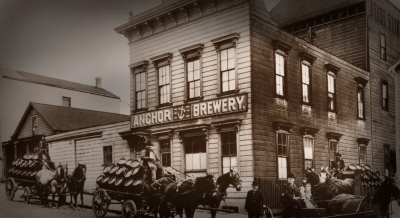
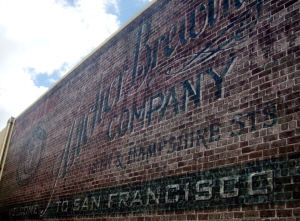
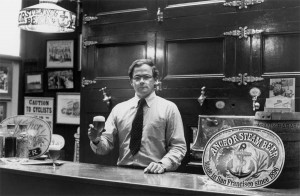
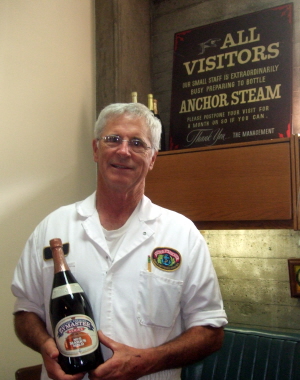
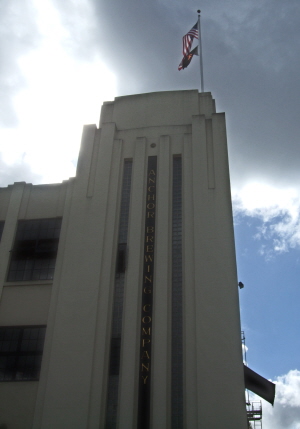
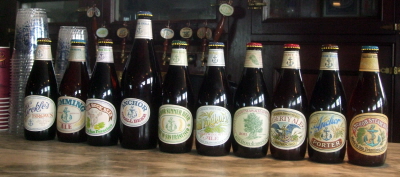
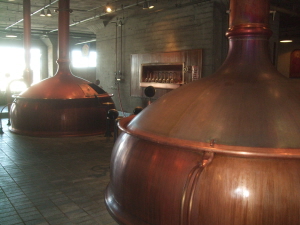

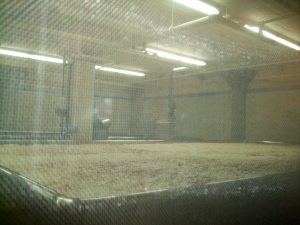
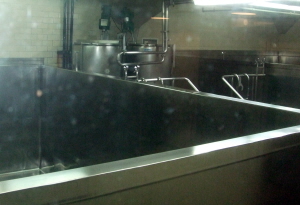
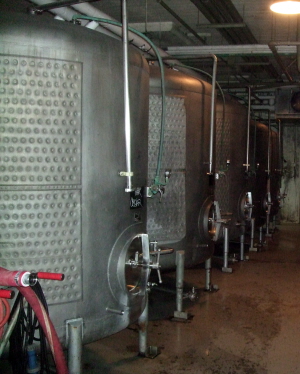


Fantastic writeup, Des.
I was devastated when I was told they had no tour places when I visited SF in 2011. The concierge at our hotel managed to get us in, and I was so glad she did. What a great place!
A great read, well done Des.
Fascinating to read that Anchor uses, in effect, the dropping system with its steam beer, albeit a hybrid of dropping and Yorkshire squares. I visited the brewery in 1990, and remember clearly being struck at how shallow the fermenting vessels were, but I didn’t know enough about brewing techniques at that time to take in the “double drop”.
Very interesting
Very good report with some interesting detail not previously known, e.g. the fact that before the early 70’s yeast for brewings was constantly being changed. This probably contributed to the inconsistency the beer was known for when Maytag bought Anchor Brewing.
I have been sampling the beers since the early 1980’s (the steam and others) and find them basically unchanged since then.
I wonder though if i) the continuation of the fermentation in a second, deeper tank, and ii) the cold-conditioning described were practised when Fred Eckhardt helped make a brew at Anchor in the early 70’s. If not, this might explain why he thought initially that the character had changed, i.e., even though he seemed convinced finally he was wrong.
Gary
Lovely write-up, Des. glad I took the time to soak it up. one of my favourite breweries, actually – purely for the fuzzy feeling I get when drinking their beers. One of my first beer loves (well, US beer) was Porter, and I still think it’s one of the best – and mose underappreciated – out there.
[…] Brewmaster Mark Carpenter. If you haven’t had a chance to read Des’ piece, “Anchor and the birth of craft beer,” check it out for some in-depth Anchor history and some great quotes from […]